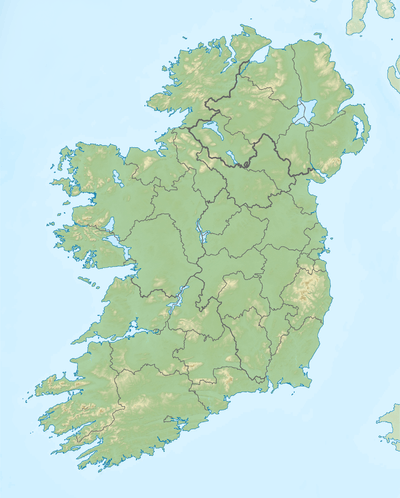Kilmeena ambush
| ||||||||||||||||||||||||||||||
The Kilmeena ambush was an action during the Irish War of Independence that took place at Kilmeena, County Mayo on 19 May 1921. The ambush ended in defeat for the local West Mayo Irish Republican Army (IRA), with six IRA volunteers killed and seven wounded. Two members of the Royal Irish Constabulary (RIC) and one Black and Tan were also killed in the action.
Background
The IRA in west Mayo was relatively quiet until January 1921, when Michael Kilroy, described as, "a puritanical and ascetic blacksmith"[1] took over command of the Brigade after Tom Derrig was arrested by the British. Kilroy formed a relatively large "flying column" of 40–50 men to carry out attacks on British forces in the area. On 6 May they suffered a reverse at Islandeady, when a British patrol came upon the IRA men cutting a road; three volunteers were killed and two captured.[2]
Ambush
On 18 May 1921, the IRA decided to attack an RIC/Black and Tan convoy at Kilmeena. Two small-unit attacks were made on the RIC barracks in Newport and Westport to try to draw the police out of their well-defended barracks. One RIC man died in these attacks.[3]
At 3am the next day, 19 May, the column of 41 IRA men took up position close to Knocknabola Bridge. The British convoy, travelling from Newport to Westport, consisted of two Crossley lorries and one Ford touring car—a total of about 50 men. The convoy did not arrive until 3pm and its arrival sparked a two-hour fire-fight. In the battle, one RIC man, Beckett, was wounded and later died. The British regrouped around the house of the parish priest, Father Conroy, and launched a counterattack.
Four IRA volunteers were killed. They were Seamus Mc Evilly, Thomas O'Donnell, Patrick Staunton and Sean Collins. Paddy Jordan of the Castlebar battalion was injured and died later at Bricens Hospital in Dublin. action.[4] Seven more IRA men were wounded.
The remainder of the column, carrying their wounded, fled over the mountains to Skerdagh, where they had safe houses. However, the British tracked them there and, in another exchange of fire, another IRA man was killed, Jim Brown from Newport.[5]
Aftermath
The British forces threw the dead and wounded IRA men on to the street outside the RIC barracks in nearby Westport, causing widespread revulsion among the local people. The Marquis of Sligo, no friend of the republican guerrillas, visited the barracks to complain of their treatment of enemy dead. At the funerals of those killed, in Castlebar, the British allowed only close family to attend and forbade the draping of the Irish tricolour over the coffins.[6]
The local IRA blamed their defeat in the ambush on the failure of an IRA unit from Westport to show up in time.
Kilroy's column managed to get some revenge for the setback at Kilmeena the following month (3 June) in an action at Carrowkennedy, where they killed seven policemen and captured 16.[7]
References
- ↑ Michael Hopkinson, The Irish War of Independence, p. 134
- ↑ Hopkinson, p. 134
- ↑ Hopkinson, p. 134
- ↑ http://towns.mayo-ireland.ie/WebX?14@95.MQffck37mav.0@.ee7b74c
- ↑ Hopkinson, p. 134
- ↑ Hopkinson, pp. 134-135
- ↑ Hopkinson, p. 135
